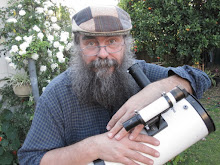Thursday, December 17, 2009
An Earth-like world, around a Sun-like star, but ....
 Next time you are up in the morning looking at Saturn and Mars, let your eye wander over and down to Spica, the brightest star in the constellation Virgo. About halfway between that and the brightish star Gamma Hydri, is a dim, unprepossessing star; 61 Virginis (helpfully highlighted in the diagram opposite).
Next time you are up in the morning looking at Saturn and Mars, let your eye wander over and down to Spica, the brightest star in the constellation Virgo. About halfway between that and the brightish star Gamma Hydri, is a dim, unprepossessing star; 61 Virginis (helpfully highlighted in the diagram opposite).A mere 28 lightyears away, 61 Virginis is a Sun-like star that harbours at least three planets, discovered in a joint venture between the Keck Observatory and the Anglo-Australian Telescope (yes, Aussies had a hand in this) using radial velocity measurements . Measurement of minute Doppler shifts in the stars spectrum lead to the conclusion that the system has two Neptune like worlds, and one Super-Earth of 5 Earth masses, 61 Virb. The other reported 5x Earth Mass planet Gliese 581c, orbits a Red Dwarf star.
 Although the star is Sun-like, and the planet is Earth-like (if a 5x Earth mass is sufficiently "Earth" like), the orbit is not. 61 Virb screams around its sun in 4.2 days, in an orbit well inside that of Mercury (not as close as WASP 18b though). The two Neptune mass planets 61 VirC and 61 VirD are also inside the orbits of Mercury and Venus, respectively, on elongated orbits. So this is a very "unsolar" solar system, unlike GJ 758b, which is a Jupiter-like planet in a solar system-like orbit around a Sun-like star.
Although the star is Sun-like, and the planet is Earth-like (if a 5x Earth mass is sufficiently "Earth" like), the orbit is not. 61 Virb screams around its sun in 4.2 days, in an orbit well inside that of Mercury (not as close as WASP 18b though). The two Neptune mass planets 61 VirC and 61 VirD are also inside the orbits of Mercury and Venus, respectively, on elongated orbits. So this is a very "unsolar" solar system, unlike GJ 758b, which is a Jupiter-like planet in a solar system-like orbit around a Sun-like star. The orbits of 61-Virginis b, c and d. B and c orbit closer than Mercury does to our sun (this and above image generated with Celestia).
The orbits of 61-Virginis b, c and d. B and c orbit closer than Mercury does to our sun (this and above image generated with Celestia).You can read the original press release here. You can read the paper that will be published soon in The Astrophysical Journal here.
If you want to add the 61 Virginis system to Celestia, cut and paste the parameters below to a file and save it as 61Virb.ssc in the extras folder of Celestia.
=====================8<=cut===================================
"b" "HD 115617"
# 61Virb, vying for lowest mass exoplanet yet, with sunlike star
{
Texture "venuslike.*"
NightTexture "venuslike.*"
#Color [0 0.36 1]
#Albedo 0.05
Mass 5.1 # M.sin(i) = 5.1 Earths
Radius 12600
InfoURL "http://en.wikipedia.org/wiki/61_Virginis_b"
EllipticalOrbit {
Period 0.0115
SemiMajorAxis 0.05021
Eccentricity 0.12
Inclination 86
ArgOfPericenter 105
MeanAnomaly 166
}
Obliquity 82 # guess, to match inclination
#EquatorAscendingNode 96 # guess, to match ascending node
# likely to be in captured synchronous rotation
}
AltSurface "limit of knowledge" "HD 115617/b"
{
Texture "extrasolar-lok.*"
}
"c" "HD 115617"
# 61Virc Neoptune like with sunlike star
{
Texture "exo-class2.*"
Color [0.98 0.97 1]
Albedo 0.75
Mass 18.2 # M.sin(i) = 18.2 Earths
Radius 49528
InfoURL "http://en.wikipedia.org/wiki/61_Virginis_b"
EllipticalOrbit {
Period 0.1041
SemiMajorAxis 0.2175
Eccentricity 0.14
Inclination 86
ArgOfPericenter 341
MeanAnomaly 177
}
Obliquity 82 # guess, to match inclination
#EquatorAscendingNode 96 # guess, to match ascending node
# likely to be in captured synchronous rotation
}
AltSurface "limit of knowledge" "HD 115617/c"
{
Texture "extrasolar-lok.*"
}
"d" "HD 115617"
# 61Vird another Neptuneoid, with sunlike star
{
Texture "exo-class4.*"
NightTexture "exo-class4night.*"
Color [0 0.36 1]
Albedo 0.05
Mass 22.9 # M.sin(i) = 22.9 Earths
Radius 51118
InfoURL "http://en.wikipedia.org/wiki/61_Virginis_b"
EllipticalOrbit {
Period 0.3368
SemiMajorAxis 0.476
Eccentricity 0.35
Inclination 86
ArgOfPericenter 314
MeanAnomaly 56
}
=====================8<=cut===================================
Labels: exoplanet, extrasolar planet, Observational Astronomy, peer-reviewed research



 Click to read about or order
Click to read about or order Click to read about or order
Click to read about or order Click to read about or order
Click to read about or order Click to read about or order
Click to read about or order




